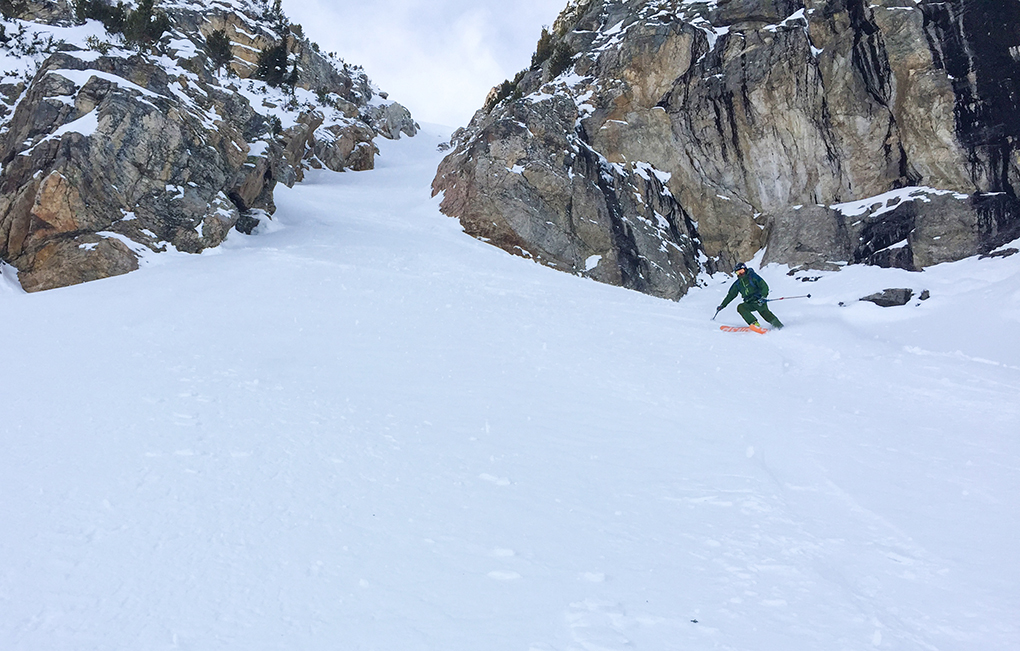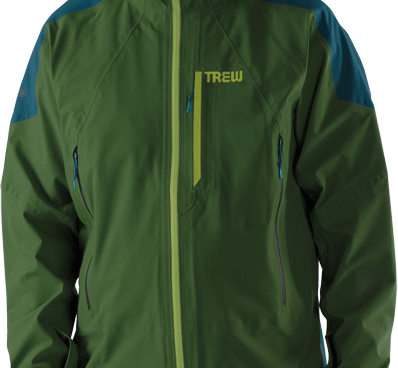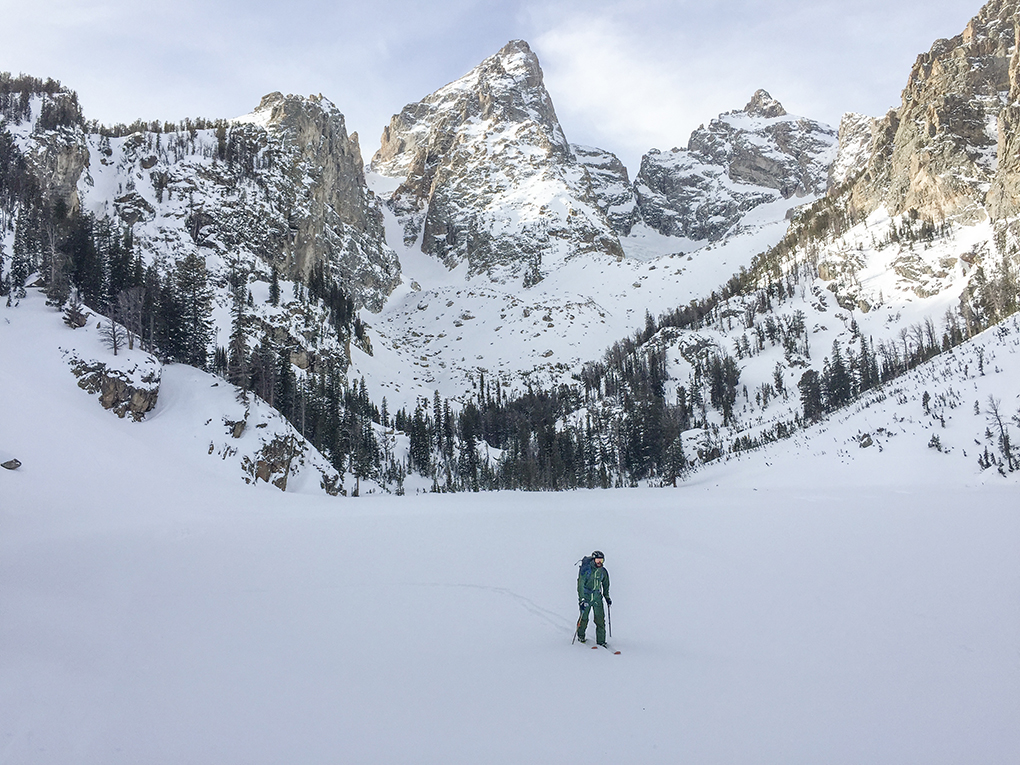Waterproofing
While I have yet to ski in a full-on downpour in the Wander, I have encountered a wide range of conditions, including postholing (or, more accurately, wallowing) through deep snow with heavy precipitation and temperatures in the low thirties. Through it all, the Wander has kept me dry, with no water penetrating the membrane.
I have, however, wet out the face fabric of the Wander a couple of times. During the aforementioned deep-snow wallow, I wet out the shoulder material near my backpack straps. It dried quickly and no water made it through the membrane. Later, while hiking a couloir in warmer temperatures, I wet out the material around the cuff while repeatedly plunging my pole and Whippet.
Both of these situations occurred in high wear areas where it’s likely that the DWR coating could have worn off, and I’m reasonably confident that, depending on the DWR treatment, a full Gore Pro jacket would have performed similarly.

It’s best to think of the Wander as a super breathable touring jacket rather than as a piece that is guaranteed to protect your from sustained, torrential downpours. I would be comfortable touring in the Wander in a wet area like my home in the PNW, but if there is significant rain in the forecast, I would definitely consider reaching for something less breathable that put more of an emphasis on waterproofing.
Pockets, Vents, and Hood
Pockets: The Wander Jacket’s pockets are laid out very well for backcountry travel. The two interior mesh stuff pockets easily fit a hat, gloves, and goggles, and could fit skins if necessary.
The two exterior hip pockets are the best pockets I’ve used on any touring jacket. They are huge, I can easily fit both my skins inside of one, and they are easy to access without taking off the backpack. The majority of the zipper runs between the chest strap and thigh belt of my backpack, allowing me to stow my skins without ever taking the backpack off.

The media pocket is also sized generously and easily fits a phone, wallet, or sunglasses. It also has an interior port from the exterior pocket that allows you to run headphones from your phone inside the jacket and still access the phone from the outside. I don’t tour with headphones, but on the rare occasion I take the Wander inbounds, I appreciate this feature.
Vents: The Wander’s pit zips are long, and run mostly along the side of the jacket, not the underside of the arm. This makes them easier to access to open or close. While they don’t feature double headed zippers, I found that they were easier to operate, and interfered less with a backpack than any other jacket I’ve used.
Hood: The Wander’s Hood is adjustable with a simple tab in the back. It’s definitely on the smaller end of the spectrum, and is snug when worn over a size Large helmet. Without a helmet, the hood stays tight over a hat, and the brim does a good job of keeping out the elements without decreasing visibility.
Other Features
The Wander’s hem is adjustable with a pull cord system that I found easy to operate, even when wearing gloves. It shaves weight by cutting the powder skirt, and since I used it with the Roam Bib, I didn’t have any issues with snow getting in. The Wander also has a passive RECCO reflector that’s sewn into the top of the shoulder and sits about 3” outboard of backpack straps.
Durability
After 17 days of touring that included some mixed climbing and questionable bush-whacking decisions, the Wander still looks brand new. The fabric shows no signs of wear and the velcro cuffs are still clean and functional. I mentioned earlier that the DWR may be losing some of its potency in high wear areas like the shoulders and the cuffs, but overall the Wander has lived up to our previous good impressions of Trew’s durability.
I’ll be putting the Wander through the ice axe and crampon gauntlet later this year and will update the review if I run into any issues.
Weight and Price
At a weight of 595 grams (size Large) and a price of $419, the Wander is competitive in both categories. Compared to a full Gore Pro, “50/50” resort / backcountry jacket, it weighs just a touch more than the Sweet Protection Supernaut LINK (587 g) but costs significantly less ($419 vs. $699).
On the other end of the spectrum, it’s heavier than the mountaineering-oriented Patagonia Refugative (446 g) and just a bit cheaper ($419 vs. $499). I’d be hard pressed to name a less expensive shell that delivers the performance and well-thought-out features of the Wander.
Who’s It For?
Trew markets the Wander as a touring jacket, and it is a very good one. If you’re going to be skiing exclusively inbounds, there are heavier, more fully-featured jackets available.

However, if you spend a significant amount of time on the skin track, it’s hard to go wrong with the Wander. If you can live without a powder skirt, it does fine pulling double duty inbounds. But where its cut and features really shine are on long days that include lots of vertical.
Bottom Line
Trew has done a great job on the touring-specific Wander jacket. The Dermizax NX membrane delivers great breathability and durability, and the Wander’s cut, features, and pockets shine on the skin track, all without breaking the bank.

Sorry the comments is slightly off topic, but any chance Blister will be reviewing the Trew Kooshin mid layer? Really curious how it stacks up against the Air-nano.
Hey Justin!
We’re planning on reviewing that piece ASAP, and I agree, the Nano-Air should be a great comparison.
Thanks!
Great, can’t wait.
Any update on the function of this jacket in the past couple years? Have you used this in heavy rain?
I’ve used this jacket for 2 winters of ski touring.
It’s awesome!
On warmer days if it’s wet or windy (20 – 40 f) I wear it over a thermal undershirt.
On cold stormy days (-20 – 15 f) I wear it over a thin fleece.
It breathes and vents incredibly well to dump heat.
It keeps me warm and dry and the hood is great – with or without a helmet.
I’m 6’3, 185 pounds and I wear a large. Perfect fit.
I can wear my puffy under or over.
“I don’t tour with headphones, but on the rare occasion I take the Wander inbounds, I appreciate this feature.”
I am amazed, is this allowed inbounds? Personally being able to hear people skiing around me makes me feel a bit safer.